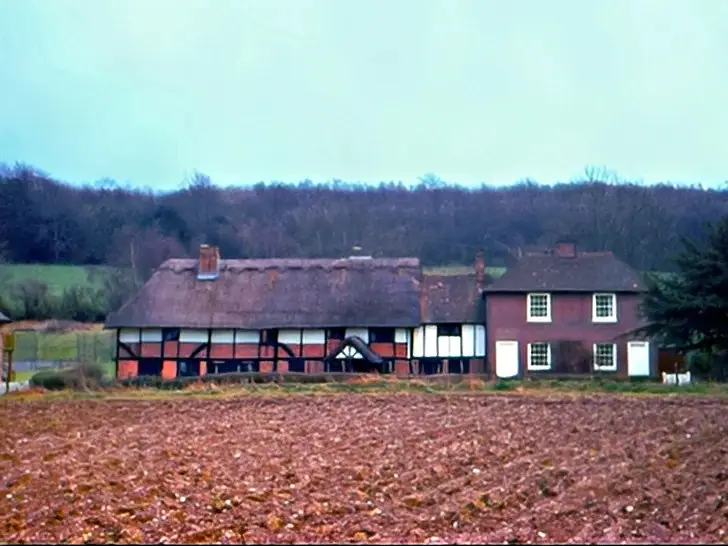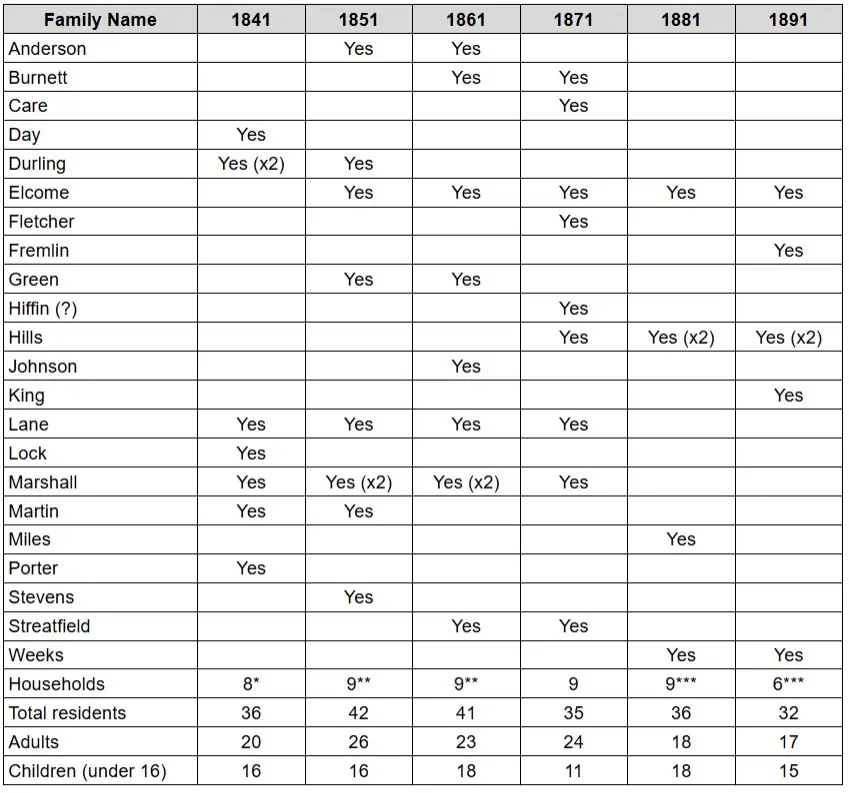The Old Malthouse
The Old Malt House and Malt House Cottage, Malthouse Road, Ash, Kent, TN15 7PJ
Grade II listed (Historic England Ref: 1275666)
The long-accepted History of Ash suggests that the Malt House “was five cottages alleged to have been built in the 14th century. It has been extensively altered and converted through the years, but never entirely demolished.”
The building(s) were grade II listed in 1982 with the following description: “This is a 17th century or earlier restored, thatched timber-framed building. It has exposed diagonal braces, modern brick, and some plaster infilling. It has a 19th-century thatched gabled porch. A later red brick extension to the right-hand side is two storeys high and has seven casement windows. There is a part timbered annexe linking with the old house.
The Old Malthouse is just in the parish of Ash-cum-Ridley, but is often thought to be in the Parish of Stansted. The boundary line between Stansted and Ash runs along the southern hedgeline of Malthouse Cottage and then northwards along Malthouse Road before cutting the corner and joining Pease Hill.
A malthouse is usually a long, low outbuilding where barley is converted into malt by soaking it in water in a cistern, allowing it to sprout, and then drying it in a kiln to stop further growth. The starch in the barley converts to maltose as it dries, and malt is produced. The malt is then used to brew beer. In the eighteenth century, many villages had a malthouse. Malthouses are different from oast houses, as oast houses were used only for drying hops.
1. 1792 Survey
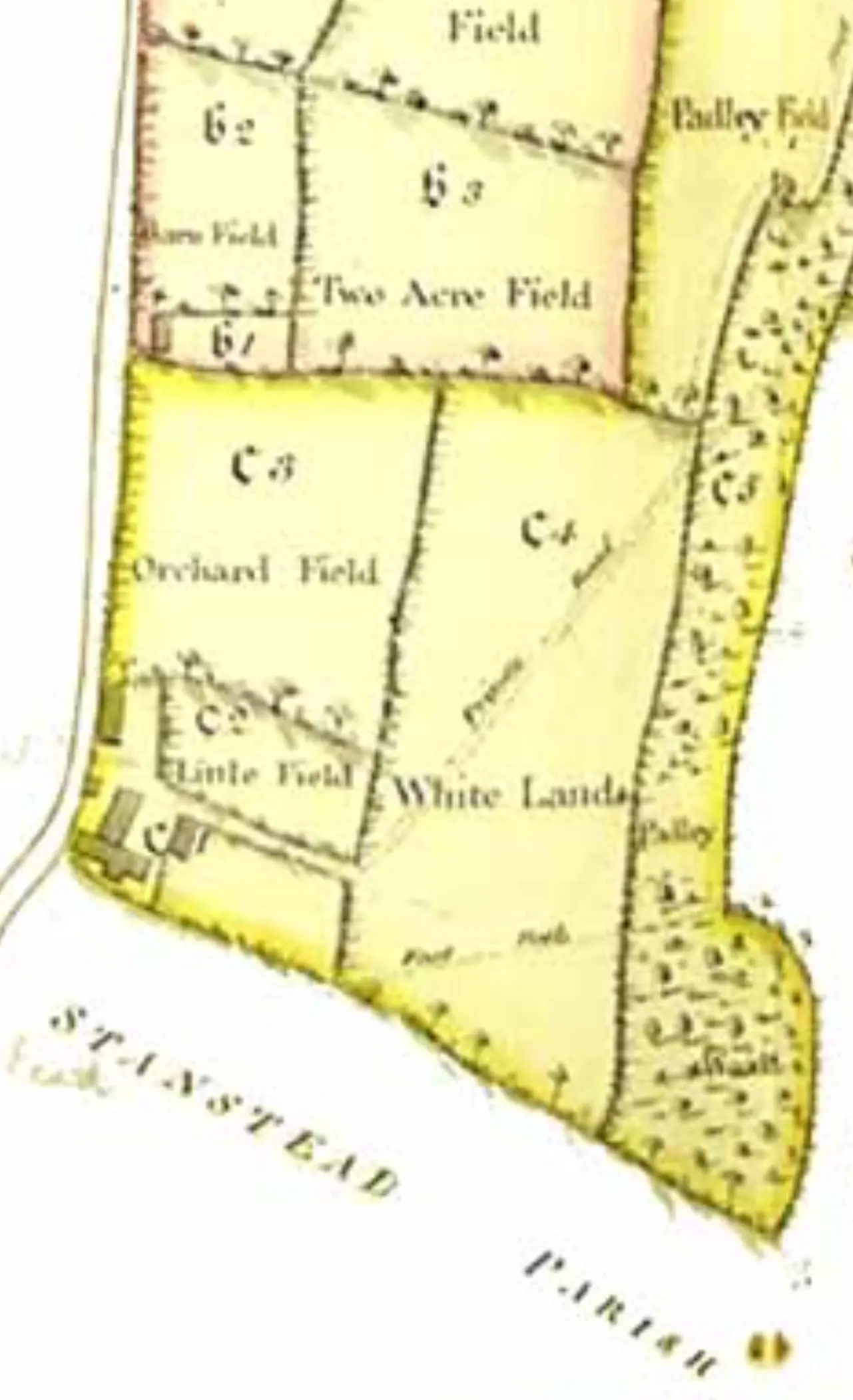
In 1792, a full survey of land in Ash was carried out by surveyor Thomas Fulljames. His map and schedules have been preserved, and they clearly show and describe the buildings we now know as The Old Malthouse and Malthouse Cottage. They are shown with other buildings and are collectively called Padley Farm. Padley Farm was owned and run by Michael Fletcher, one of the Fletcher family, whose main property was Rands House, now Holywell Manor. He is listed as living in “The Homestall Yard and Garden” at the farm. Together with fields and woodland, the whole area was 23 acres. Interestingly, it is noted that no hops were being grown on the land.
2. Early 1800s
An interesting entry is copied from the Holywell Park Estate accounts of 1804 -1818, which reads, “Joseph Fletcher received £8 annually from Ash Parish for the use of the Malt House for brewing beer”. Working people drank Home-brewed beer at every meal, costing about 4d per gallon. So it is almost certain that the long-established Padley Farm had gradually diversified into brewing and became known as the Malthouse.
Growing hops to flavour beer was widespread in the area, with Kent producing half of all the hops grown in England and Wales.
In 1835, the county had 25,740 acres of hop ground. By the peak year of 1878, this acreage had increased to 46,600. By 1904, the acreage had fallen to 29,841.
James Preston wrote a book, ‘Malting and Malthouses in Kent’, which includes the following:
“It is possible that a square projection to the rear at the south-east end, which was marked on the OS second and third editions, had been the kiln. In 1825, buildings in Stansted used as a malthouse with a dwelling house adjoining were leased by Henry Streatfield and his wife Hannah to Edward Lawrence of Stanstead, maltster, for twenty-one years at £90 per annum.”
3. 1835
The red brick house to the right (now Malthouse Cottage) has a plaque on its front which says “J + F 1835”. The 1792 map shows a much longer building running at right angles to the road on this site. The red brick building is in Georgian style, and it seems reasonable to assume that the old long building (possibly including the kiln mentioned by James Preston) was demolished at that time and the new building was constructed. The JF on the plaque is probably James Fletcher Junior, listed as the owner in 1841. Malthouse Cottage has two front doors, indicating that it may have once been two cottages.
4. 1841 Tithe map and schedule
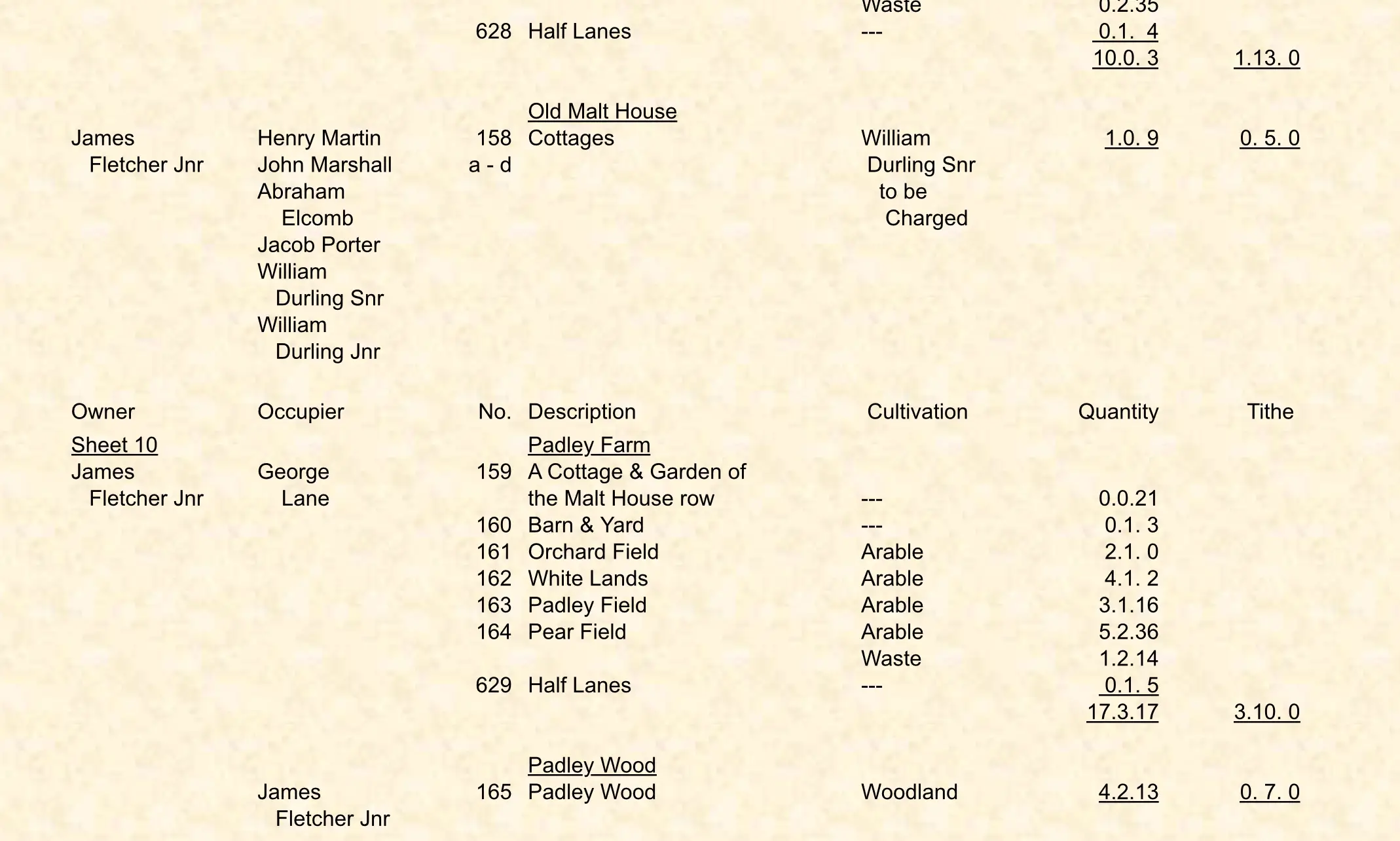
By the time of the 1841 tithe map, the property is clearly a run of 5 dwellings (a-d called the Old Malthouse) and a fifth dwelling in the row (furthest from Stansted) called Padley Farm. The tithe map, usually so accurate, is ambiguous about which dwelling was which. The whole lot was still owned by James Fletcher Junior.
Clearly, although the property is still in the same ownership, something has changed since 1792. Then there was a single occupier who lived on site. By 1841, the buildings accommodated many farm labourers and their families. Possibly, malting had stopped on site, and the released buildings were put to residential use.
5. 1841 – 1891 Census details
The 1841 census lists eight families living in the house, divided into separate cottages.
From 1841 to 1891the census shows an average of 9 families living on the site; 37 individuals in total. Almost all the adult men were agricultural labourers, and the wives worked to raise the family and run their households, but otherwise, they did not have employment. Just under half of the residents were under 16, so you can imagine what a thriving place it once was. However, let us not paint a rosy picture – rural life was hard, money was scarce, and existence was somewhat precarious. Some children are listed as scholars, but many males under sixteen in the census details are listed as ‘Agricultural Labourers’, including one lad (John Lane) who was eleven years old in 1861. As John Julius Norwich said, “Civilisation as we know it today came to us only after a thousand years of struggle, suffering, and unspeakably hard work on the part of our ancestors. We, its beneficiaries, have good cause to be grateful.”
The census details are held in full in the village archive. The table below summarises the names and numbers of families living on site. It is also notable that many of the people living there were born within two miles of the farm.
Notes:
* In 1841, two separate Durling families were living at the Malthouse
** In 1851 and 1861, two separate Marshall families were living here
*** In 1881 and 1891, two separate Hills families were living here.
6. 1900-1930
So we have seen that around the beginning of the 1800s, the use of the buildings had changed from a traditional farm to a small housing project for agricultural workers with a farm attached. A century later, by 1900, this process seems to have gone in reverse, and by 1911, the families had disappeared, and the property was back in single residential use. This has continued to the present day.
In 1901, there were three households (the Fremlins, Marchants and Brooks), 14 people total of whom one was under 16. In 1911, there was one household (the Fletchers), nine people total, of whom four were under 16.
It is very noticeable that farm labouring was in decline. Different occupations are listed, such as Journeyman butcher, Traction Engine driver, Carrier and Bricklayer. This could be a development in the way census enumerators collected data. Who knows?
7. 1930s
The next interesting phase in the history of the Old Malthouse relates to the 1930s when it became a “spacious and pleasant restaurant, with a large open fireplace of brick and a comfortable lounge-annexe.” A book, “Road Houses and Clubs of the Home Counties 1934”, tells us: “A choice and varied luncheon is obtainable every day until 2.30 p.m. and afternoon tea may be taken either indoors or, in fine weather, on the lawn. From 7 o’clock onwards, there is an excellent five-course dinner, which is served until a late hour; a skilful chef with an amply stocked larder is always at the disposal of such patrons as may require refreshments after ordinary hours. A fine radio-gramophone provides music for dancing enthusiasts at all times, and on the weekly Gala Nights, which take place every Friday, a good band is in attendance. A limited number of bedrooms are available.”

In 1939, Arthur Mee published his book “The King’s England, Kent” by Arthur Meeand included the following:
“A little more than a mile on the road to Ash stands an old house with wattle and daub in its walls, the primitive form of building with hazel twigs interlaced and filled with mud and straw. The Old Malt House, which all may see, has still this reinforced mud in its walls, and had been made beautiful with a new thatch when we called, a sturdy place again after its 500 years.”
For several years, it was owned by a widow who later became Mrs. Kerr Tyre. She and her husband continued to live here for some years after their marriage. They moved to Belfast as Mr. Tyre was a manager of Short Brothers of Rochester, which moved its Aeroplane Works to Belfast after the 1939-1945 war.
8. Post WW2
Mr. Brittain and family were the next occupants [see 11 below].
They were followed by Dr. W. Ewart Mahon, his wife Inger, and their three children. He was a consultant in general medicine at the Brook Hospital in Woolwich and an author of papers concerning hypertension and respiratory diseases. He later bought and restored Attwood Place (in what is now New Ash Green) and was an expert in antiques.
Following Dr. Mahon was Cranley Onslow, his wife, Lady June Hay, and their four children. Cranley Onslow was a prominent Conservative politician who moved to Woking in the 1960s and subsequently became Baron Onslow of Woking.
The Harding family owned the property until the late 1970s when Mr E Brindle took ownership (see below).
9. 1980 – 2014
The website ‘Stansted and Fairseat – yesteryear and today has this to say in 2014 “I passed The Old Malt House (over on Malthouse Road, Stansted) today and the removal vans are there, so it seems a new owner is about to move in. A few weeks ago, I bumped into the man who had lived there for 34 years with his wife and family [Mr and Mrs Brindle]. He told me a little history of the House. When they bought it, it comprised about five or six cottages. They converted the end two into a separate house (Malthouse Cottage) in 1980 and sold that. They knocked the remaining cottages into one house, which is there today.“
10. 2014 to Present day
The map attached to the 1792 survey includes a detailed footprint for the buildings on site, which differs in some respects from what exists today. The noticeable differences are:
- A barn to the left of the driveway no longer exists. A little further back in the site, on that side, is a garage block with living accommodation above.
- Malthouse Cottage was built in 1835 and replaced a larger building that ran at right angles to the thatched house.
- A road that ran from the current driveway entrance through the site and into the field behind no longer exists and has been partially replaced by a hedge separating the gardens of the Old Malthouse and Malthouse Cottage.
Claire Godfrey and Phil Chamberlain add, “We purchased the Old Malthouse in February 2014 from Eric and Tina Brindle. Eric was the pharmacist at New Ash Green. They had all the alterations done to separate the Old Malthouse from Malthouse Cottage and put upstairs bedrooms in the Old Malthouse. They also had the footpath re-routed as it had previously gone through the garden. At one time, they had a chicken farm up on the meadow. They began the work to create a conservation meadow, which we have continued. Eric and Tina were in their 70s and had poor health. They were moving to be near their daughter.
Margaret Moore and her husband had purchased Malthouse Cottage from Eric and lived as neighbours for many years. Sadly, Margaret`s husband had a heart attack up in the woods above the house and died. This was fairly soon after buying Malthouse Cottage. Margaret was a teacher and later shared her home with Ann, another teacher. When we moved in, Margaret sold us her part of the meadow and wood as she could no longer manage it. This reunited the 12 acres of meadow and woodland. Margaret was somewhat nervous about change when we moved in, but we soon became firm friends until her death at 75. Neil and Julia Chamberlain, our current lovely neighbours, then moved in about 7 years ago.
The flood in June 2019 required considerable work to restore the house, and we were out of the house for 18 months. The listing required us to have a conservation limecrete and stone floor installed, which should help preserve the house. As part of the post-flood restoration, planning required us to have an archaeologist present when the floor was dug out.
We continue to manage the land for conservation as a chalk downland hay meadow, which is now very rare. We have seen the number of orchids rise year on year and think it helps that we have the hay cut late to allow flowers to set seed.
11. Some of the families who lived at the Malthouse
Much of this information has been gathered from Frank Proudfoot’s unpublished History of Ash, “A Downland Parish”, chapter 11. Also from Ancestry.com and from the internet.
11.1 The Lanes
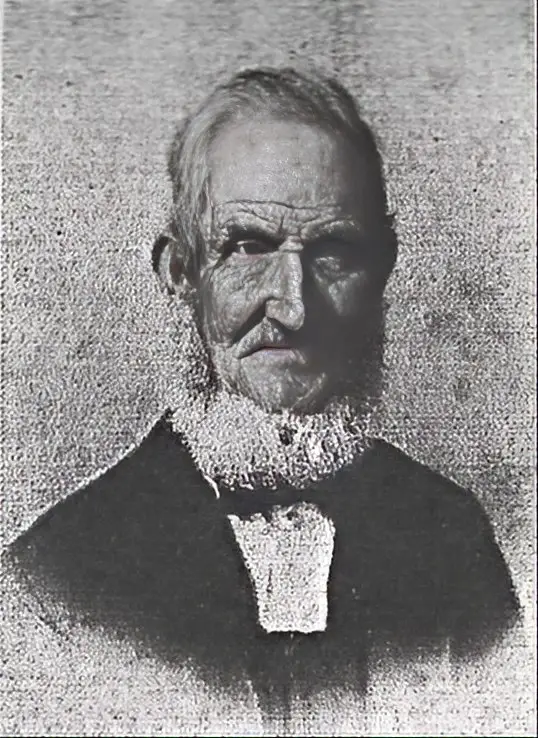
In the 1841 census, there were eight families at the Malthouse with George Lane senior and his family in one of the dwellings, still known as Padley Farm. George Lane was shown as an agricultural labourer. He was more than this as he also rented 30 acres of land from John Alliston of Ha[y]tham Green Farm. This land was situated on the western side of Malthouse Road between Bakers Wood and the (now) Recreation ground. This brought the land under his stewardship to 47 acres. His family were still living there in 1871, but they had moved away by 1881.
11.2 The Elcomes
There was an influx of new families into Ash during the middle years of the eighteenth century, and amongst the newcomers at that time were the family of Elcome, otherwise known as Ellcombe, Elcomb, Elcombe, or Elcom.
Although the Elcomes were known to farm, or perhaps more usually to till the soil in a humbler capacity, they also filled, in later years, the more specialised roles of shoemakers, schoolmasters, census enumerators and parish clerks. In times of widespread illiteracy, schoolmasters and parish clerks were not easy to come by in country parishes, and it must have been a considerable boon to the neighbourhood to possess in its midst a family that could adequately fulfil those duties and keep it shod as well.
John Elcome, in 1851, was an agricultural labourer living at the Old Malthouse, which had a population of forty-two and accommodated nine households. John’s menage, which included a three-year-old grandson, contributed a total of nine. The family tended to be peripatetic, within the usual limited range, and the six of John’s children then at the Malthouse were variously born at Ridley, Longfield, Hartley and Ash. One of the sons, another John, continued there for many years. By 1871, when he was still in occupation, the numbers had fallen somewhat, but there was then accommodation for ten families, one unit being vacant.
11.3 The Fletchers
The Fletchers seem to have arrived in Ash at much the same time as the Elcomes. They first noticed through the christening of Mary, daughter of Joseph and Mary Fletcher, on New Year’s Day, 1758. A Michael Fletcher, of whom more later, was probably the infant’s elder brother, born before the move to Ash. Several more children followed Mary. The last born, James Fletcher, was to become the family Croesus.
The Fletchers were a farming family, but agriculture made only a modest contribution to their advancement. Although Joseph Fletcher became the owner of Rands House Farm, the nucleus of what in more recent times was the extensive Holywell Park estate, only some fifty-seven acres went with the house in his day. Michael Fletcher owned Padley Farm, of which the Malthouse was the homestall; its acreage, or at least its acreage in Ash, was modest, and initially Michael only ranked as a husbandman.
Joseph Flitcroft Fletcher, who lived with old James at Rand’s House, owned a cottage and land at Seafields. James Fletcher junior was at Ridley Court but owned Padley Farm.
Michael Fletcher married, at Shoreham, a girl named Sarah Petman; she presented him with seven sons and three daughters, but three of the sons died in infancy. The Fletchers were by no means universally successful. One of Michael’s sons, Joseph, described himself as a farmer in 1841, when he was living in Ash Street, but he seems not to have prospered as such. Ten years later, he was an ‘annuitant’, having perhaps been pensioned off by his uncle James. At the age of seventy-six, by which time ‘he had moved on to West Yoke’, he was in business of sorts as a land measurer. One of his daughters, Susannah, was a schoolmistress, and another, Emily, was a dressmaker for a time. In 1871, at which time some of the family were living well in the vicinity of Hodsoll Street, Joseph’s son of the same name, a widower, and his son, aged thirteen, were occupying one of the numerous abodes provided by the Old Malthouse; both were agricultural labourers.
11.4 Cranley Gordon Douglas Onslow
Baron Onslow of Woking (8 June 1926 – 13 March 2001) and his wife Lady June Hay, daughter of George Hay, 14th Earl of Kinnoull. They had four children. He was a British politician and served as the Conservative MP for Woking from 1964 to 1997, and a British peer from 1997 until his death in 2001. In 1984, he was elected to chair the 1922 Committee and was considered the most powerful backbencher in the Conservative Party. In this post, he had the unenviable job of conveying to Mrs Thatcher the desire of backbenchers that Leon Brittan should resign over the Westland affair and in the 1990 leadership contest that many backbenchers wanted a broader choice of candidates, thus contributing to her decision to drop out. This angered many allies of Thatcher, and in 1992, he was toppled as Chairman of the 1922 Committee by Marcus Fox.
He was a keen cricketer and regularly participated in Stansted Cricket Club matches. Ashley Whatman recalls that after he moved to Woking, he hosted annual cricket matches between Stansted and his local team for some years.
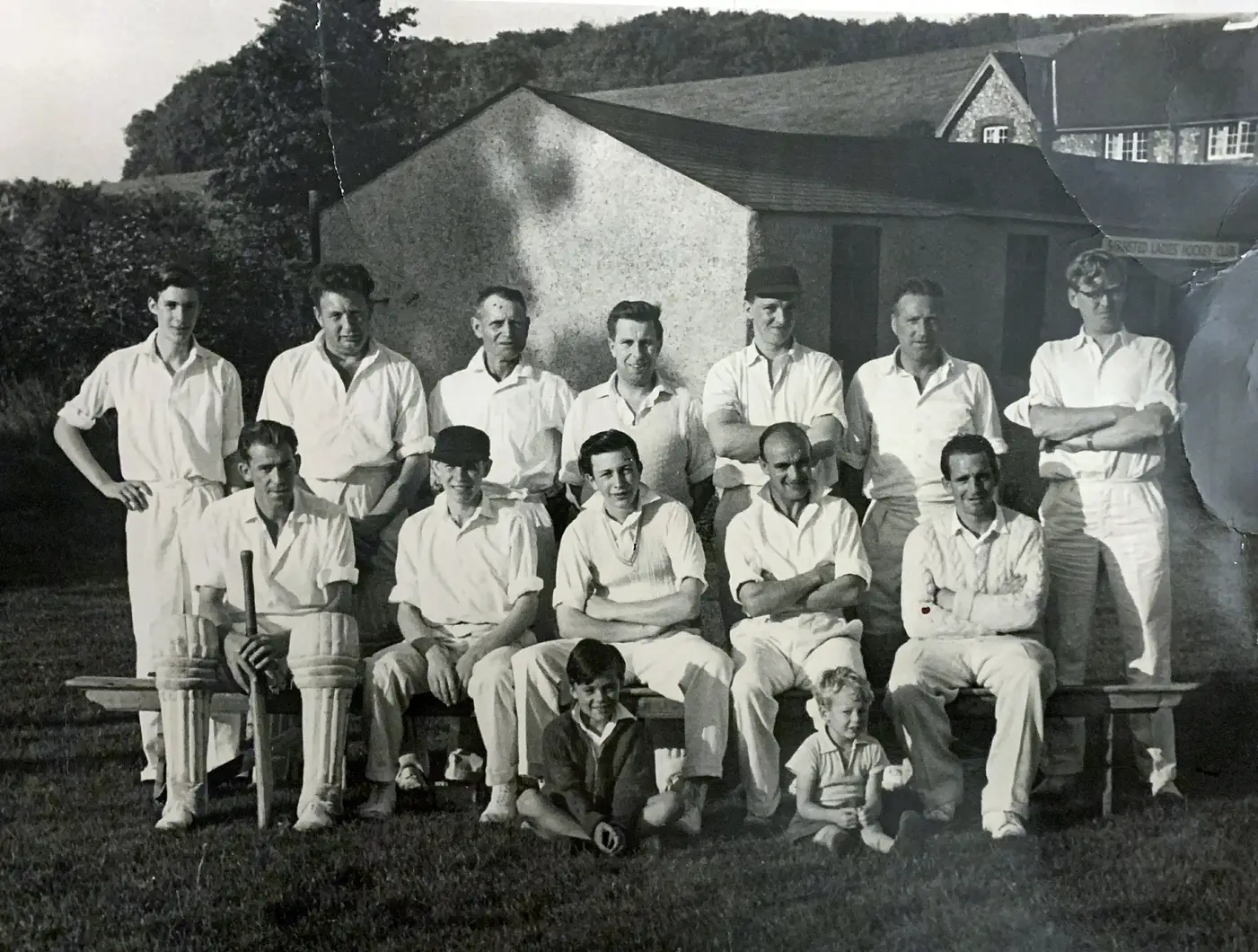
Author: Dick Hogbin
Editor: Tony Piper
Acknowledgements: The History of Ash – Ash Parish Council. A Downland Parish – Frank Proudfoot. Stansted and Fairseat – Yesteryear and today https://stanstedandfairseat.blogspot.com
Last Updated: 17 June 2025

